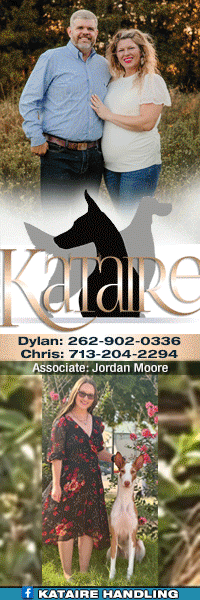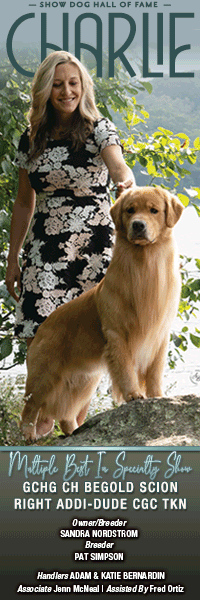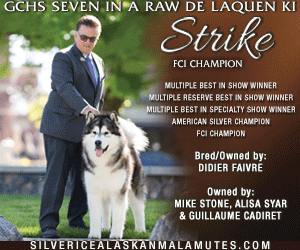Interview with Author Ted Kerasote
By Debra Lampert-Rudman
“Although we may be able to extend their life span by improving their nutrition, breeding, and care, it’s almost certain that dogs will never live as long as we do. Yet, across this bittersweet divide, which separates us so finally from them, we reach out – again and again and again”
– Ted Kerasote
For more than five years, Ted Kerasote was on a mission; traveling the world questioning leading experts: geneticists, veterinarians, dog breeders, pet food manufacturers, and others, seeking answers to the question all of us have asked after losing a beloved dog: “Why do they die so young.”
Many answers are detailed in his latest book, Pukka’s Promise: The Quest for Longer-Lived Dogs including diet, environmental conditions, and vaccinations; however, according to Kerasote, a large part of the solution rests with dog breeders, particularly show dog breeders, and judges.
Kerasote, best-selling author of the memoir Merle’s Door: Lessons from a Freethinking Dog, cited as possibly, “…the best book ever written about dogs,” by Elizabeth Marshall Thomas, author of The Hidden Life of Dogs and a “must read” by Temple Grandin, began his quest after his beloved Merle’s passing at the age of 14 from brain cancer, a passing which Ted lovingly describes in heartrending detail, along with the extended hospice care he gave Merle at home.
Meeting Merle: 20 Years Ago
Ted, a passionate outdoorsman and award-winning author, found Merle – or more accurately, Merle picked Ted – while on a rafting trip with friends along the banks of the San Juan River in 1991. Merle, a Golden-red “houndy Lab” with some Golden Retriever mixed in, had inquisitive brows and loved “singing”. The two connected instantly and Merle, used to surviving on his own, exposed Ted to new ideas of life with dogs: dogs as peers. Without expecting to find him, Merle was the dog Ted unconsciously needed: one who would thrive as an independent, athletic, and intelligent dog in their small Wyoming village. The “door” in the title was the dog door installed in Ted’s home through which Merle – and his friends – conducted their lives with, and separate, from Ted and their owners. Readers of Merle’s Door were introduced to life in and around Kelly, Wyoming, as seen through Merle’s eyes. Ted and Merle hunted for their food together, skied and climbed towering mountains together, rafted together, and traveled the world developing a deep bond.
Pukka’s Promise carries readers back to the glorious mountaintops, waterways, and wildlife of northwestern Wyoming with Ted, the lively, free-roaming Pukka, a now 4-year old, intact male: the pup after, and reminiscent of, Merle; and both their canine and human friends. Pukka, like Merle, learns to “leave it” when otters call him to swim; how to break trail for perfect skiing; and is Kelly’s Deputy Mayor of sorts, visiting folks in and around the village on a daily route, always returning home to Ted for dinner, hikes, and other sporting adventures.
The book’s detailed and highly-researched chapters focus largely on factors people can control when selecting and raising a dog including: purebred vs. mixed-breed, training, exercise, healthy toys and chews, the ethics of diet and nutrition, vaccinations and health care, health testing, environmental toxins, the spay/neuter question and other options including maintaining an intact dog and tubal ligation, as well as an extensive resource chapter and notes.
Breeders and Judges Hold Keys to Longer-Lived Dogs
In a recent phone interview, Ted described his initial search for his pup, one that included visiting a diverse number of shelters and breeders and weighing the pro’s and con’s of purebred vs. mixed breed. Knowing he wanted a Labrador retriever with the houndy attributes of Merle, he visited many breeders.
“In the book I was clear that you should go to a reputable breeder – you should visit the kennel where the dog is bred,” Kerasote said. “I did not go to a show breeder because I had no desire to have a show dog. I wanted a working dog, all about function and for many breeds that is no longer the case.”
Pukka is descended from Labrador Retrievers for 30 generations; Ted analyzed Pukka’s pedigree and coefficient of inbreeding before purchasing him. He also visited the breeder’s home several times, meeting both the sire and dam, and encourages readers to do the same when looking for a pet.
Pukka is purebred Labrador, “but as I tried to point out in the book, back in the early part of the century, Lab breeders were looking for new blood…so breeders of labs started bringing foxhounds into the breed. I believe that there are these houndy labs like Pukka, like Merle, who still have hound-like traits from a century ago… I think many of our Labrador retrievers, especially our field labs, do have some of those leftover houndy genes in them.”
In Pukka’s Promise Ted writes, “After speaking with many breeders in both North America and Europe, I began to develop a theory. I noticed that a considerable number of breeders involved in the show world share two characteristics: a strong competitive drive to win blue ribbons and a love of how a dog looks instead of how it performs. I suspect that it is these two qualities that begin to take some breeders down a slippery slope, one dog at a time, overriding first caution, then common sense, and finally compassion.
“…I met breeders and breed standards that simply create unhealthy dogs,” Kerasote said. “How can you look at some modern (dogs) and say that that Standard is creating a healthy dog?”
Kerasote remarked that in the years spent researching his book, he repeatedly, “ran up against breeders who were erring on the side of the dog who looked a certain way but who could no longer perform as members of the breed performed half a century ago.”
He said he also ran into judges who would look at the breed standard and then award blue ribbons to, “dogs who, in the casual observer’s eye, did not meet that breed standard at all. “
Kerasote went on to say that there are lots of breeders who are not like the above but, “we wouldn’t be in the straits we’re in with dog health if the show world hadn’t gone too far in the direction of form rather than function.”
“Judging Seems to be the Problem”
The “most impressive person” Kerasote met in his travels and research was the United Kennel Club President Wayne Cavanaugh. According to Kerasote, Wayne Cavanaugh believes that judging seems to be the problem with dog health.
“That’s where he pins the blame,” Kerasote said. “Wayne Cavanaugh gives Judges seminars every few weeks trying to walk judges through the historic breed standard and the breed standard as it now exists…instead of always erring on the side of the dog that has a little bit more of an exaggerated feature, for example a Bassett Hound whose belly drags on the earth.”
In the book, Kerasote points out that Wayne Cavanaugh started with reforming the German Shepherd standard. “He basically said that German Shepherds with low slung back ends will no longer win in UKC events. He’s calling that the UKC’s moral duty to the canine world.”
In conversations with AKC representatives, Kerasote said he found that AKC claims the breed clubs own the standards. When asked if he believed that breed clubs, rather than a registering body, would be most knowledgeable about their own breed’s health, form and function, he said not much is happening in some breed clubs.
“The Swedish, Finnish, Norwegian and the British Kennel Club have taken the bull by the horns and said, ‘You breed clubs are not being proactive enough for the health of dogs,” Kerasote added.
According to Kerasote, the Swedish Kennel Club began proactive measures in the mid-1970s requiring breed clubs to devise healthier breed standards to produce healthier dogs, or risk their breed not being eligible for registration.
“As far as I can tell, the AKC is not being the most pro-active kennel club in the world right now,” Kerasote said. “The AKC has many good things going for it, but it isn’t leading the way for its breed clubs and encouraging them to produce healthier dogs.”
Ted believes there are a tremendous amount of good breeders putting their hearts and souls into it. “But they aren’t doing enough to get all the bad breeders and the slack-off breed clubs in line to produce healthier, longer-lived dogs,” he stated. “Good breeders should work through the AKC encouraging their clubs to be more pro-active voices in producing healthier dogs for everyone.”
Shelters and Rendering Plants: Bearing Witness
Before finding Pukka, Kerasote visited shelters throughout the country searching for a “houndy lab” like Merle. Several of the most moving passages in the book revolve around Kerasote’s visits to shelters and rendering plants where deceased shelter dogs are disposed.
“My goal in this book was to be comprehensive and rigorous – to cover all the factors that are generally noted as affecting the canine life span and not to offer secondhand reporting about it – but to go and see for myself – to bear witness,” Kerasote said.
Sitting outside a building at a large shelter, Kerasote “waited for the animal control officers to lead the condemned dogs across the compound.” He watched as healthy dogs and later cats considered unadoptable for various reasons were brought into a “killing room” for lethal injections.
“We hear all the time, ‘Well, 1.5 million healthy dogs are euthanized in our shelters.’ People talk about dogs being ‘put down’, ‘destroyed’ is the British word, but very few of us have actually seen that happen. I thought it imperative that I bear witness to what is going on every day in our shelters and make people aware of it so that people could no longer use the world ‘euthanize’ (which comes from the Greek and literally means ‘the good death’) for healthy dogs being killed.”
The book also describes promising programs in which poor, Southern shelters are working together to ship healthy dogs to shelters in other parts of the country where they have greater chances of being adopted.
When describing improved nutrition and diet for healthier dogs, the book includes a great deal of information, including a chapter entitled, “Should a Wolf Eat Corn?”, on corn, corn products, and rendered ingredients found in dog food.
“Rendered products are used ubiquitously, and someone needed to speak to this issue of dogs and cats being killed in shelters and then being rendered with a firsthand eye witness report. There’s been so much misinformation and hyperbole around the issue of rendering – I wanted to lay it to rest once and for all and tell it as truthfully as I could about how rendered products go into pet foods.”
Kerasote feels it is very easy for the public to dismiss what goes on in overcrowded shelters, and what goes into our dog’s food, with euphemisms. “Someone has to portray what is happening here and that is what I did.”
A Pukka Blueprint
According to a note at the front of the book, the word “pukka” comes from the Hindi and means “genuine” or “first-class”. In our society, most dogs can’t live a “freethinking” life; most of us don’t hunt for our, or our dog’s, food; and most of us don’t eat, or feed our dogs, a completely organic, natural diet; and, most unfortunately, overcrowded shelters won’t magically find homes for every dog in their charge, however, Ted Kerasote presents a comprehensive blueprint for future generations of healthy, longer-lived dogs while sharing his own joys in raising a healthy, vibrant Pukka.
About The Author
Debi Lampert-Rudman is a Freelance Writer, a Ceramic Artist represented by The William Secord Gallery, and breeds and shows Parti-Color Cocker Spaniels under the Topaz Cockers prefix. A member of the American Spaniel Club, Cocker Spaniel Club of New Jersey, and Board Member, Match Show and Publicity Chair of the Morris & Essex Kennel Club; Debi lives in Pennington, New Jersey with 5 cocker spaniels and her husband, Richard. She can be reached at bonbritany@aol.com
Short URL: http://caninechronicle.com/?p=30667
Comments are closed














